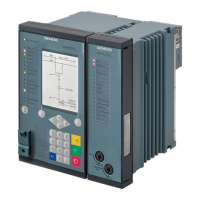Overvoltage Protection with 3-Phase Voltage
Overview of Functions
The function Overvoltage protection with 3-phase voltage (ANSI 59) is used to:
•
Monitor the permissible voltage range
•
Protect equipment (for example, plant components, machines, etc.) against damages caused by over-
voltage
•
Decouple systems (for example, wind power supply)
Abnormally high voltages in power systems are caused by voltage controller failure at the transformer or on
long transmission lines under low-load conditions.
When using common-mode reactors in the protected power system, the device must shut down the line
quickly if the reactors fail (for example, due to fault clearance). The insulation is endangered by the over-
voltage condition.
Overvoltages at capacitor banks can be caused by resonances with line or transformer inductances.
In power plants increased voltage levels can be due to one of these factors:
•
Incorrect operation when controlling the excitation system manually
•
Failure of the automatic voltage controller
•
After full load shedding of a generator
•
Generators which are disconnected from the network or in island mode
Structure of the Function
The Overvoltage protection with 3-phase voltage function is used in protection function groups with
voltage measurement.
The Overvoltage protection with 3-phase voltage function comes factory-set with 2 Definite-time over-
voltage protection stages. In this function, the following stages can operate simultaneously:
•
3 stages Definite-time overvoltage protection
•
2 stages Inverse-time overvoltage protection
Stages that are not preconfigured are shown in gray in the following figure.
[dw3phovp-030211-01.tif, 4, en_US]
Figure 7-140 Structure/Embedding of the Function
7.13
7.13.1
7.13.2
Protection and Automation Functions
7.13 Overvoltage Protection with 3-Phase Voltage
SIPROTEC 5, High-Voltage Bay Controller, Manual 783
C53000-G5040-C015-9, Edition 11.2017

